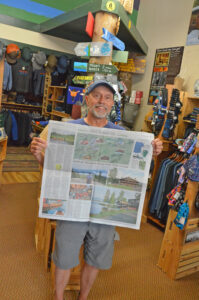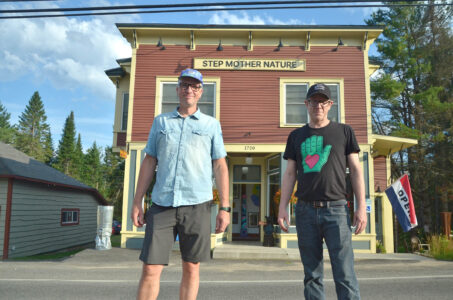Get in touch with nature with a naturalist on the VIC trails
- Naturalist Thompson Tomaszewski examines a beech bud, a sought-after food source for many animals in the winter, on Saturday at the Paul Smith’s College VIC. (Enterprise photo — Jesse Adcock)
- Naturalist Thompson Tomaszewski pierces the nodules on a balsam tree, letting the resin run on Saturday at the VIC at Paul Smith’s College. (Enterprise photo — Jesse Adcock)
- The colors water can be more easily discerned when frozen, seen on Saturday at the VIC at Paul Smith’s College. (Enterprise photo — Jesse Adcock)

Naturalist Thompson Tomaszewski examines a beech bud, a sought-after food source for many animals in the winter, on Saturday at the Paul Smith’s College VIC. (Enterprise photo — Jesse Adcock)
SARANAC LAKE — A fragrant method to tell a balsam tree from any other conifer — pierce its trunk and see if aromatic resin drools out. Naturalist Thompson Tomaszewski makes sure to teach everyone who comes a naturalist walk with her at Paul Smith’s to identify a balsam tree by its resin, and also with by light underside of its needles.
“The wilderness is alive and well and very, very busy,” Tomaszewski said. “You just have to know what you’re looking for.”
Out of the VIC’s varied terrain, the Heron Marsh is the quietest during winter. The amphibians and fish have gone dormant in the marsh’s comparatively warmer depths. The emergent vegetation, which starts growing in the water then emerges into the surface, waits for spring.
“You might see like a muskrat or a river otter if you’re lucky and the day is right,” Tomaszewski said.
Snags, any dead tree still standing upright, are left alone unless they pose a threat to visitor safety, Tomaszewski said. They dot the flora alongside trail, valuable homes to insects and fungi.

Naturalist Thompson Tomaszewski pierces the nodules on a balsam tree, letting the resin run on Saturday at the VIC at Paul Smith’s College. (Enterprise photo — Jesse Adcock)
Tomaszewski said that though the wilderness is quiet in the winter, this is not for a lack of activity. Some birds have migrated south. Some mammals, like chipmunks, have found warm burrows to hibernate in. Tomaszewski pointed to the many trails and traces in the snow — squirrel and deer track most easily recognized, as evidence of ongoing activity.
A lot of wildlife “really change their behavior in winter,” Tomaszewski said. “Competition for any resource has increased.” This varies from creature to creature. For instance, she said, chickadees prefer insects, but in the winter pivot to plant matter.
And while some birds and squirrels bury and store food for the winter, others have to make due with less desirable options. In deer and snowshoe hair, this means relying on the little buds on small trees or shrubs like witch-hobble.
Red squirrels leave recognizable traces of their foraging — Tomaszewski said they break off pieces spruce branches, eat the bud at the end of the branch, and then toss away the remainder. This results in the litter of inch-long spruce branches at the base of trees.
But some life happens away from prying eyes, in “a miniature secret world that only exists in the winter,” Tomaszewski said. Voles, moles and shrews make use of the gap left by sublimating snow to carve out networks of tunnels and byways. Above ground these byways are still hidden by the snow’s surface.

The colors water can be more easily discerned when frozen, seen on Saturday at the VIC at Paul Smith’s College. (Enterprise photo — Jesse Adcock)
“They are insulted from really cold temperatures at the surface, protected from predators, and have access to some really nice green food sources,” Tomaszewski said.
Temperatures stay a relatively constant 32 degrees down in this subnivean zone, even when it’s below freezing at the surface, Tomaszewski said. Not only the small creatures make use of the insulating properties of snow — Tomaszewski pointed to deer tracks leading wide, shallow holes in the snow. That was evidence of a deer bedding down and covering itself with a layer of snow, she said.
And snow’s ability to leave a record does not stop at wildlife.
“Another cool thing about winter here,” Tomaszewski said, “you can really tell the color of the water when it freezes.”
While in the warmer seasons it might be easy to miss differences in hue, when frozen, the reddish brown water of Barnum Brook is striking. Tomaszewski said this color comes from the surrounding hemlock trees and high iron content in the soil.
“We came from the woods,” Tomaszewski said. “In the woods we find peace and comfort.”
Paul Smith’s College hosts naturalist walks at the VIC nearly every Saturday at 1 p.m. until March 31st. They’re $10 and snowshoes are required — pairs are available to be rented at the VIC if you don’t have your own.







